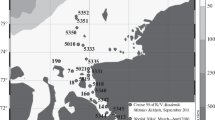Abstract
Physical, chemical and biological parameters have been measured in the water column of Saelenvann, a shallow estuary in western Norway, over a period of nearly 4 years. Due to the presence of a permanent pycnocline, a layer of anoxic water with high sulfide and ammonia concentrations persists under a layer of oxic water with normal photosynthetic and heterotrophic microbial activities. The magnitude of the sulfate reduction in the estuary was correlated with the magnitude of primary productivity. Increases in sulfate reduction following increased primary productivity occurred first in the free anoxic water, and only after an appreciable time lag in the upper sediment layers. The highest rates of sulfate reduction were found just below the interface with the oxic water and in the upper few centimeters of the sediment. It is estimated that twice as much sulfate is reduced in the free water mass as in the sediment. During the summer, the amount of organic material produced by primary productivity exceeds the amount of organic material mineralized by sulfate reduction, the inverse being the case during the winter.
Similar content being viewed by others
Literature Cited
Abd-el-Malek, Y. and S.G. Rizk: Counting of sulfate reducing bacteria in mixed bacterial populations, Nature, Lond. 182, p. 538 (1958)
——: Culture of Desulphovibrio desulphuricans, Nature, Lond. 185, 635–636 (1960)
American Public Health Association: Standard methods for the examination of water and wastewater, 13th ed. 874 pp. Washington: A.P.H.S. 1971
Culkin, F.: The major constituents of seawater. In: Chemical oceanography, Vol. 1. pp 121–161. Ed. by J.P. Riley and G. Skirrow. London: Academic Press 1965
Gemerden, H., van: On the bacterial sulfur cycle of inland waters, 110 pp. Thesis, University of Leiden 1967
Golterman, H.L.: Methods for chemical analysis of fresh waters, 188 pp. Oxford: Blackwell Scientific Publications 1971 (IBP handbook No. 8)
Jørgensen, B.B.: The sulfur cycle of a coastal marine sediment (Limfjorden, Denmark). Limnol. Oceanogr. 22, 814–832 (1977)
— and T. Fenchel: The sulfur cycle of a marine sediment model system. Mar. Biol. 24, 189–209 (1974)
Kelly, D.P., L.A. Chambers and P.A. Trudinger: Cyanolysis and spectrophotometric estimation of trithionate in mixture with thiosulfate and tetrathionate. Analyt. Chem. 14, 898–901 (1969)
Le Gall, J. and J.R. Postgate: The physiology of sulphate-reducing bacteria. In: Advances in microbial physiology. Vol. 10. pp 81–133. Ed. by A.H. Rose and D.W. Tempest. London: Academic Press 1973
Pfennig, N. and H. Biebl: Desulfuromonas acetoxicans gen. nov. and sp. nov., a new anaerobic, sulfur-reducing, acetate-oxidizing bacterium. Archs Microbiol. 110, 3–12 (1976)
Richards, F.A.: Anoxic basins and fjords. In: Chemical oceanography, Vol. 1. pp 611–645. Ed. by J.P. Riley and G. Skirrow. London: Academic Press 1965
Ruttner, F.: Fundamentals of limnology, 307 pp. Toronto: University of Toronto Press 1963
Sorokin, Yu.I.: Experimental investigation of bacterial sulfate reduction in the Black Sea using 35S. Mikrobiologiva 31, 402–410 (1962) [Transl. Microbiology 31, 329–335 (1962)]
Sparling, J.H. and B.M. Hennick: The production of hydrogen-sulphide in peats. Folia microbiol., Praha 19, 59–66 (1974)
Strickland, J.D.H. and T.R. Parsons: A practical handbook of seawater analysis, rev. ed. Bull. Fish. Bd. Can. 167 1–310 (1972)
Strøm, K.M.: Land-locked waters. Skr. norske vidensk-Akad. (Mat.-naturv. Kl.). 7, 1–88 (1936)
Widdel, F. and N. Pfennig: A new anaerobic, sporing, acetate-oxidizing, sulfate-reducing bacterium. Desulfotomaculum (emend.) acetoxidans. Archs Microbiol. 112, 119–122 (1977)
Author information
Authors and Affiliations
Additional information
Communicated by T.M. Fenchel, Aarhus
Rights and permissions
About this article
Cite this article
Indrebø, G., Pengerud, B. & Dundas, I. Microbial activities in a permanently stratified estuary. I. Primary production and sulfate reduction. Mar. Biol. 51, 295–304 (1979). https://doi.org/10.1007/BF00389208
Accepted:
Issue Date:
DOI: https://doi.org/10.1007/BF00389208




